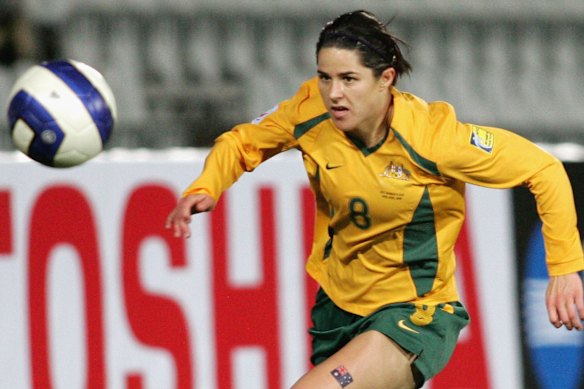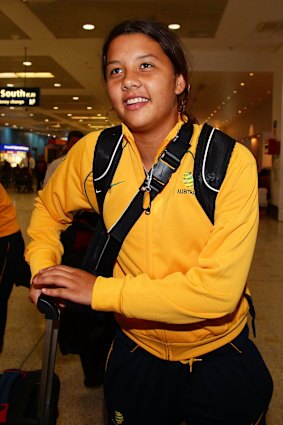The 5.1 million reasons Asian Cup is set to ignite the country in 2026
By Emma Kemp
Sarah Walsh was a Matildas striker the last time Australia hosted a Women’s Asian Cup, in 2006. It was the first time qualifying to a World Cup through Asia, and expectations were low.
“Then Lisa [De Vanna] and I turned it on and we were scoring goals, and our belief grew during the tournament,” says Walsh, who recounts making the final under Tom Sermanni before losing the decider on penalties in front of 5000 mostly China supporters at Adelaide’s Hindmarsh Stadium.
“But I think that was the foundational Matildas moment for competing in Asia. And that was really important for us because powerhouses like China, Japan, and Korea, we had them up on a pedestal, and that was our moment where we felt like we truly belonged.”
Two decades later, as the 2026 tournament’s chief operating officer, Walsh has history from which to draw. After 2006 came 2010, when Walsh and a 16-year-old Sam Kerr helped the Matildas to their only continental trophy to date in China. That’s before even fathoming the Matildas mania that has swept Australia since the 2023 World Cup.
Still, a few days out from Tuesday’s official draw at Sydney’s Town Hall, this player-turned-administrator is just as interested in giving India’s team their moment in the sun as part of a broad-brush approach to filling seats with Australia’s vibrant Asian diaspora.
“In some ways it is about the football, but it’s actually about so much more than that,” Walsh says. “When was the last time outside of cricket that India were able to celebrate a women’s moment like this in sport? They’ve been starved of these moments, and we’re really going to tap into that.”

Sarah Walsh during the 2006 semi-final against Japan at Hindmarsh Stadium.Credit: Getty Images
Earlier this month, India did the unthinkable and qualified for the Women’s Asian Cup. Sure, they got a start in the 2022 tournament by virtue of being the host nation, but even then were forced to withdraw after the opening match when a major COVID-19 outbreak left them unable to field a squad.
This time, under new head coach Crispin Chhetri, they did it on merit, sealing their spot in the 12-team tournament via a 2-1 win, away, and over highly fancied Thailand.
So there’s history made right there – as with fellow debutants Bangladesh, who are the first Bangladeshi national team to qualify for an Asian Cup since the men at Kuwait 1980.
Both inclusions are a big deal for the dense populations located within those respective countries, but they also shape as significant for the large populations who live here.

Sarah Walsh is chief operating officer for the 2026 Women’s Asian Cup.Credit: Kate Geraghty
“When you think about the community sizes, Bangladesh, the numbers are about 48,000 Australians that identify with that heritage, and India is over 1.1 million,” she says. “And we know they love to represent and celebrate their culture … turn up to a match with those countries playing, you’ll be able to experience that culture.
“We’re thinking very carefully about how we bring that to life for the 27 matches. We’re not just selling a ticket, we’re selling an experience for these communities to connect, on a very large scale, with their own communities.”
The same goes for communities with connections to Japan, Vietnam, China, Taiwan, North Korea, South Korea, Iran, the Philippines and Uzbekistan, who will also compete to become continental champions from March 1-21 next year.

A young Sam Kerr arrives back in Sydney after the Matildas’ victory in the 2010 Asian Cup final.Credit: Getty Images
Latest census data from 2021 shows 5.1 million Australians had ancestry from Asian Football Confederation (AFC) nations – a figure projected to swell to 6.5 million by 2026. In Greater Sydney, 35 per cent of residents had ancestry from AFC nations and in Western Sydney, where the host venues Stadium Australia and Commbank Stadium are located, it’s 40 per cent.
In Greater Perth and southeast Queensland – the other host regions – those numbers are 19 and 14 per cent respectively.
The approach of organisers has been informed by the massive home success of the 2015 men’s Asian Cup, won by the Socceroos but also attended by unexpectedly high numbers across many other fixtures. And, of course, the 2023 Women’s World Cup, which opened Australia’s eyes to previously unseen women’s football nations.
“We are one of 47 nations within the AFC, and we happen to be one of the most multicultural countries within the AFC,” Walsh says. “Combined of those 11 countries, about 3.4 million Australians identify with one of those communities. So it’s not just going to be about the Matildas, this one, it’s going to be about bringing multicultural Australia, Asian ancestry to life, and we’re excited. That’ll play out Tuesday night as well.”
Organisers expect a big media contingent, including overseas press from China, Bangladesh, Malaysia, Singapore, Saudi Arabia, Pakistan and the United Kingdom.
For those with a singular focus on the Matildas, the draw is critical to hometown hopes of finally lifting the major trophy that has so far eluded this so-called golden generation.
The 2023 World Cup was a momentous almost-there moment, but it is worth remembering that Australia only qualified in the first place because they were the host nation. They may not have made it at all had their fate rested on results at the 2022 Asian Cup, the qualifying tournament from which Tony Gustavsson’s side were knocked out in the quarter-finals and would, in other circumstances, have been forced into playoffs.
There will be no such luck this time, meaning Joe Montemurro’s in-transition team must at least make the semi-finals to secure automatic qualification for the 2027 World Cup or face AFC playoffs and possibly even inter-confederation playoffs. Also at stake is the 2028 Olympics, with quarter-finalists progressing to the qualifying tournament.
The Matildas are in Pot 1 alongside favourites Japan and North Korea, meaning they will be drawn with one of defending champions China, runners-up South Korea and Vietnam from a strong Pot 2, along with one of the Philippines, Taiwan and Uzbekistan in Pot 3 and Iran, India and Bangladesh in Pot 4.
How well they are placed come their opening match at Perth’s Optus Stadium – and their chances of contesting the final at Sydney’s Olympic Stadium – is unclear, given the results of Montemurro’s recent first window in charge read two wins, a draw and a loss against Panama with a heavily experimental squad and the still-questionable status of captain Kerr.
Ticket sales were opened to the public on Friday and, while Walsh cannot yet reveal pre-sale numbers, says, “they’re very, very strong”.
“And in parallel to the Euros going on now, we’re looking to break records for the Women’s Asian Cup,” she says. “I played in the 2006 Asian Cup in Adelaide; I can tell you this is very different.”
Football has a new Home. Stream the Premier League, Emirates FA Cup, J.League and NWSL live & on demand, including Premier League with 4K, from August 2025 on Stan Sport.